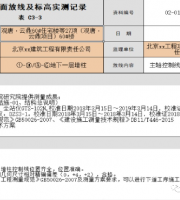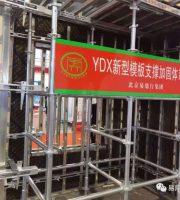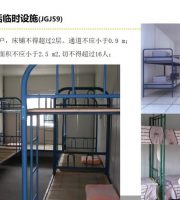(2) Strengthening measures for unconventional plastering.
Sand stacking requirements: set up a special sand tank.
4 before plastering, the inspection and acceptance procedures of preparation process shall be handled, and the acceptance data shall be archived.
The cement mortar plastering layer shall be cured under wet conditions, generally 24h after plastering.
Generally, the thickness of each layer of plastering structure should be 5 ~ 7mm, and the thickness of lime mortar and cement mixed mortar should be 7 ~ 9mm.
When the total thickness of plastering is greater than or equal to 35mm, strengthening measures shall be taken.
Before the construction of external wall plastering works, door and window frames, guardrails, etc.
When the room area is large, the cross center line shall be snapped on the ground first, and then the wall corner line shall be snapped according to the flatness of the base surface, and then the vertical line shall be hung at 100mm away from the internal corner of the wall and the vertical line shall be popped, and then the wall plastering layer thickness control line of the two walls at the internal corner shall be turned over to the wall according to the wall corner line popped on the ground, so as to make the ash cake, and then the reinforcement shall be filled according to the ash cake.
Among them: sundries and dust on the surface of brick masonry shall be removed, and water shall be sprayed before plastering; The concrete surface shall be roughened or coated with 1:1 cement mortar (add an appropriate amount of adhesive) after watering and wetting the surface; After the aerated concrete is wet, the interface agent shall be brushed and the cement mixed mortar with strength not less than M5 shall be plastered at the same time.
The setting of dividing joints shall meet the design requirements, the width and depth shall be uniform, the surface shall be smooth and the edges and corners shall be neat.
Generally, the width of standard reinforcement is 50mm.
Generally, the plastering structure is divided into bottom layer, middle layer and surface layer.
Before plastering, the dust, dirt and oil stains on the surface of the base course shall be removed and watered.
7 protect various mortar plastering layers of finished products.
Before setting, prevent rapid drying, water flushing, impact, vibration and freezing.
The large surface must be submitted for inspection before construction; The plastering mortar shall be converted into volume ratio and measured in special containers (barrels or trucks).
When the reinforcing mesh is used, the overlapping width between the reinforcing mesh and each matrix shall not be less than 100mm.
After setting, take measures to prevent contamination and damage.
During operation, the ash cake shall be plastered first, and then the ash cake shall be plastered down.
If commercial mortar or ready mixed dry powder mortar is required, it shall be implemented as required.
When plastering with cement mortar and cement mixed mortar, the next layer can be plastered only after the previous layer is set; When plastering with lime mortar, the next layer can be plastered after the previous layer is 70-80% dry.
1、 Construction process the construction process of plastering works can be summarized into seven steps: ① base treatment → ② watering and wetting → ③ plastering cake → ④ wall reinforcement → ⑤ layered plastering → ⑥ setting dividing joints → ⑦ protecting finished products.
3.
Hanging fool type mix proportion board on the mixing site: convert the weight into container metering bucket (truck) for easy operation.
(3) Detail processing.
Requirements for plastering mortar materials: river sand (screened and graded medium sand) shall be used, and it must be submitted for inspection before large surface construction; The cement shall be the brand cement in the contract required by the region, and ordinary portland cement must be used, and the strength grade shall not be less than 32.5mpa.
Base course treatment (1) base course cleaning.
The cement shall not be expired to avoid moisture and caking.
The external corners of indoor walls, columns and door openings shall meet the design requirements.
The drip line (groove) shall be neat and straight, the drip line shall be high inside and low outside, and the width and depth of the drip groove shall not be less than 10mm.
For layered plastering, standard reinforcement shall be set before large-area plastering.
Hang vertically, set square, find rules and make mortar cake.
5.
Among them, cement mortar shall not be plastered on the lime mortar layer; The gypsum plaster on the surface shall not be plastered on the cement mortar layer.
According to the plastering quality required by the design drawings and the flatness and verticality of the base surface, use one wall as the benchmark, hang vertically, set square and find rules, and determine the plastering thickness of the plastering cake.
The spacing between two bars shall not be greater than 1.5m.
When the wall height is less than 3.5m, vertical reinforcement should be made, when it is greater than 3.5m, horizontal reinforcement should be made, and the spacing of ash cake should not be greater than 2m when transverse reinforcement is made.
Watering shall be carried out in several times.
The plastering work shall be carried out in layers.
When plastering the cake, the correct position of the cake shall be determined according to the indoor plastering requirements, and then the ruler board shall be used to find the vertical and flat.
The average total thickness of plastering layer shall meet the design requirements.
Wall reinforcement when the mortar of ash cake is 70% dry, it can be filled with the same mortar as the plastering layer.
If there are no design requirements, 1:2 cement mortar shall be used as concealed corner protection, and its height shall not be less than 2m, and the width of each side shall not be less than 50mm.
Different walls and environments require different amounts of water.
The plastering layer shall be free of delamination, hollowing, and the surface layer shall be free of ash explosion and cracks.
After mixing, the cement mortar shall be used up before the initial setting, and the hardened mortar shall not be used again.
1.
The plastering work shall be constructed after the quality acceptance of the base or base course.
2.

The parts with obvious concave convex surface shall be leveled in advance or filled with 1:3 cement mortar.
The reinforcing mesh shall be tightened and nailed firmly.
The number of reinforcement shall be determined according to the width and height of the room.
Drip line (trough) shall be made at the position with drainage requirements.
When there are no requirements in the design, the average total thickness of the plastering layer shall not be greater than the requirements in the following table.

3 the mortar on the plastering site must be placed in an ash bucket.
The quality of substrate or base course is an important factor affecting the quality of architectural decoration engineering.

Refer to the following table for specific technical requirements.
Before plastering, the missing edges and corners on the surface of block masonry found in the inspection and the slotted position shall be repaired in layers..
shall be installed first, and the construction holes shall be blocked tightly.
Finally, it is appropriate that the wall is wet and does not bleed.
5.
For the plastering of the surface at the junction of different material substrates, strengthening measures to prevent cracking shall be taken.
4.

The ash cake should be plastered into a 50mm square shape with 1:3 cement mortar.
The plastering layer must be firmly bonded with the base course and between each plastering layer.
6 set dividing joints and plaster dividing joints.
2 watering and wetting generally, the day before plastering, water the wall from top to bottom with a water pipe or watering can.
2、 Process key points based on the example of creating excellence project, interpret the process key points of plastering project construction.
1.
The strength of the plastering layer of the bottom layer shall not be lower than that of the surface layer.





